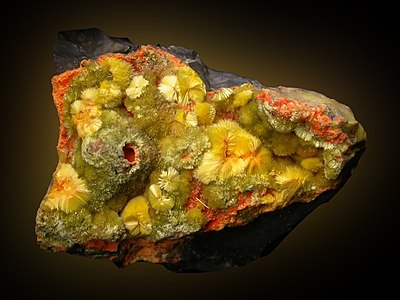Lepersonnit- (Gd)
| Lepersonnit- (Gd) | |
|---|---|
| Lepersonnite (Gd) (flat yellow crystals), fused with needle-shaped studtite (orange: Curit ) | |
| General and classification | |
| other names |
IMA1981-036 |
| chemical formula | Ca (Gd, Dy) 2 (UO 2 ) 24 (SiO 4 ) 4 (CO 3 ) 8 (OH) 24 · 48H 2 O |
|
Mineral class (and possibly department) |
Carbonates and nitrates - uranyl carbonates |
|
System no. to Strunz and to Dana |
5.EG.10 ( 8th edition : VIII / B.38) 17.1.12.1 |
| Crystallographic Data | |
| Crystal system | orthorhombic |
| Crystal class ; symbol | mm 2 |
| Space group | Pnnm (No. 58) or Pnn 2 (No. 34) |
| Lattice parameters | a = 16.23 Å ; b = 38.74 Å; c = 11.73 Å |
| Formula units | Z = 2 |
| Physical Properties | |
| Mohs hardness | Please complete |
| Density (g / cm 3 ) | 4.01 |
| Cleavage | Please complete |
| colour | light yellow |
| Line color | light yellow |
| transparency | transparent to translucent |
| shine | Glass gloss |
| radioactivity | highly radioactive |
| Crystal optics | |
| Refractive indices |
n α = 1.638 n β = 1.666 n γ = 1.682 |
| Axis angle | 2V = 73 ° |
Lepersonnite (Gd) is a very rare mineral from the mineral class of carbonates and nitrates . It crystallizes in the orthorhombic crystal system with the chemical composition Ca (Gd, Dy) 2 (UO 2 ) 24 (SiO 4 ) 4 (CO 3 ) 8 (OH) 24 · 48 H 2 O and forms wart-shaped crusts and individual spheres needle-shaped crystals are composed.
Etymology and history
The mineral was first found in 1982 by Michel Deliens and Paul Piret in the Shinkolobwe mine in Shinkolobwe in the Katanga province of the Democratic Republic of the Congo . They named it after Jacques Lepersonne, the chairman of the mineralogical-geological department of the Koninklijk Museum voor Midden-Afrika in Tervuren , Belgium .
There are several type minerals, three of which are in the Royal Museum for Central Africa (catalog number RGM13781, RGM2696, RGM13250) in Tervuren, Belgium, and another at the National Museum of Natural History (catalog number 150228), Washington, DC , USA is located.
classification
Lepersonnit- (Gd) is in the classification according to Strunz classified differently. In the 8th edition, it is one of the silicates and forms a separate subgroup of the island silicates with non-tetrahedral anions. In the 9th edition of the system , however, it is counted among the carbonates and nitrates and forms a subgroup of uranyl carbonates with sulfate or silicate.
According to the Dana system , it forms a separate subgroup of carbonates with different formulas.
Crystal structure
Lepersonnite (Gd) crystallizes in the orthorhombic crystal system with the space group P nnm or P nn2, the lattice parameters a = 16.23 Å , b = 38.74 Å and c = 11.73 Å, as well as two formula units per unit cell .
properties
With its uranium content of up to 64%, the mineral is also radioactive. Taking into account the natural series of decay or any decay products present, the specific activity is given as 114.61 kBq / g (for comparison: natural potassium 31.2 Bq / g). Lepersonnite (Gd) is the only known mineral in which gadolinium is the rare earth metal with the highest percentage. It also contains larger amounts of dysprosium and yttrium and some terbium .
Education and Locations
Lepersonnite- (Gd) forms in the lower part of the oxidation zone over uranium-containing dolomite . It is associated with Bijvoetit , Sklodowskit , Curit , Uranophan , Becquerelit , Rutherfordin and Studtit .
So far there is only one known site, the type locality Shinkolobwe in the Democratic Republic of the Congo .
Precautions
Due to the toxicity and the strong radioactivity of the mineral, mineral samples from Lepersonnit- (Gd) should only be kept in dust- and radiation-tight containers, but especially never in living rooms, bedrooms or work rooms. Absorption into the body (incorporation, ingestion ) should also be prevented in any case and, for safety, direct body contact should be avoided and respiratory protection mask and gloves should be worn when handling the mineral .
See also
literature
- Lepersonnit- (Gd) In: Anthony et al .: Handbook of Mineralogy, Vol. 1, 1990, p. 101 ( pdf ).
Web links
Individual evidence
- ↑ a b c Webmineral - Lepersonnit
- ↑ M. Deliens and P. Piret: Bijvoetite et lepersonnite, carbonates hydratés d'uranyle et des terres rares de Shinkolobwe, Zaire. In: Canadian Mineralogist. , Vol. 20, 1982, pp. 231-238 ( PDF , 1023 kB).
- ^ New Dana Classification of Carbonate Minerals
- ↑ mindat.org - Lepersonnite- (Gd)
